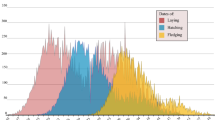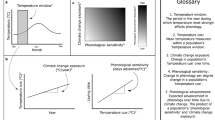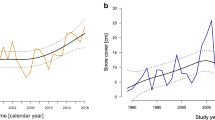Abstract
The timing of reproduction is a fundamental aspect of life history, yet the breeding seasons of most birds of the world, i.e., those in the tropics, remain poorly understood. Here, we use more than 3000 mist-netting records and 300,000 citizen scientist observations collected over 6 years to characterize the nesting, incubation, fledging, and juvenile stages of the breeding season on Singapore Island in Southeast Asia’s equatorial rainforest zone. The breeding season was compared with climate variables and food availability to identify possible proximate and ultimate causes. Breeding was seasonal and began just after the rainiest months of the year, when insect abundance was highest and when masting events were most likely to occur. While true photoperiod varied little throughout the year, overcast weather in November–December and sunnier weather in February–March caused average daily sunshine to increase by several hours at the onset of the breeding season in all 6 years. Our data suggest that subjective daily sunshine hours, which correlate with photoperiod at higher latitudes but not in the tropics, may be the actual proximate trigger of breeding activity in most of the world’s birds.
Zusammenfassung
Die Vogel-Brutsaison in einem äquatorialen Klima mit geringfügiger Saisonalität ist an Sonnenstunden gekoppelt
Die zeitliche Koordinierung der Fortpflanzung ist ein grundlegender Aspekt des biologischen Lebenszyklus, und dennoch wissen wir immer noch sehr wenig über die Brutsaison der meisten Vögel der Welt, insbesondere der Vögel in den Tropen. In dieser Studie verwenden wir mehr als 3.000 Datenaufzeichnungen von Nebelnetz-Vogelfängen sowie 300.000 Beobachtungen von Bürgerforschungsplattformen – allesamt über einen Zeitraum von sechs Jahren gesammelt – um die Nist-, Inkubations-, Flügge- und Juvenil-Stadien der Brutzeit auf der Insel Singapur in der äquatorialen Regenwaldzone Südostasiens zu charakterisieren. Die Brutzeit wurde mit Klimavariablen und Daten bezüglich der Nahrungsverfügbarkeit verglichen, um mögliche proximate und ultimate Ursachen der zeitlichen Koordinierung zu identifizieren. Brutaktivität zeigte Saisonalität und begann kurz nach den regnerischsten Monaten des Jahres, wenn Insekten am häufigsten und Regenwald-Mastereignisse am wahrscheinlichsten waren. Obgleich die wahre Photoperiode das ganze Jahr über kaum variierte, führten bewölktes Wetter von November bis Dezember und sonnigeres Wetter von Februar bis März dazu, dass die durchschnittliche tägliche Sonneneinstrahlung zu Beginn der Brutzeit in allen sechs Jahren um mehrere Stunden zunahm. Unsere Daten deuten darauf hin, dass die subjektiven täglichen Sonnenstunden, die mit der Photoperiode zwar in höheren Breiten aber nicht in den Tropen korrelieren, bei den meisten Vögeln der Erde der eigentliche unmittelbare Auslöser der Brutaktivität sein könnten.








Similar content being viewed by others
Data availability
Raw data presented in this article is available at https://doi.org/10.5061/dryad.k3j9kd5b5. Citizen science records were obtained from and are available at eBird.org.
References
Auer SK, Bassar RD, Fontaine JJ, Martin TE (2007) Breeding biology of passerines in a subtropical montane forest in northwestern Argentina. Condor 109:321–333
Baker JR (1939) The relation between latitude and breeding seasons in birds. Proc Zool Soc Lond 108:557–582
Bates GL (1908) Observations regarding the breeding-seasons of the birds in Southern Kamerun. Ibis 50:558–592
Beebe K, Bentley GE, Hau M (2005) A seasonally breeding tropical bird lacks absolute photorefractoriness in the wild, despite high photoperiodic sensitivity. Funct Ecol 19:505–512
Bell HL (1982) A bird community of lowland rain forest in New Guinea. 2 seasonality. Emu Aust Ornithol 82:65–74
Betts FN (1952) The breeding seasons of birds in the hills of South India. Ibis 94:621–628
Brandt MJ, Cresswell W (2008) Breeding behaviour, home range and habitat selection in rock firefinches Lagonosticta sanguinodorsalis in the wet and dry season in Central Nigeria. Ibis 150:495–507
Cannon CH, Curran LM, Marshall AJ, Leighton M (2007) Beyond mast-fruiting events: community asynchrony and individual dormancy dominate woody plant reproductive behavior across seven Bornean forest types. Curr Sci 93:1558–1566
Cassone VM, Yoshimura T (2015) Circannual cycles and photoperiodism. In: Scanes C, Dridi S (eds) Sturkie’s avian physiology. Elsevier, Urban, pp 829–845
Catry T, Ramos JA, Samson E, Le Corre M (2009) Does interference competition explain why white terns of Aride Island, Seychelles, breed predominantly when marine productivity is lower? Ibis 151:265–273
Chapman A (1995) Breeding and moult of four bird species in tropical West Africa. Trop Zool 8:227–238
Chiver I, Stutchbury BJ, Morton ES (2015) The function of seasonal song in a tropical resident species, the red-throated ant-tanager (Habia fuscicauda). J Ornithol 156:55–63
Chong KY, Chong R, Tan LW, Yee AT, Chua MA, Wong KM, Tan HT (2016) Seed production and survival of four dipterocarp species in degraded forests in Singapore. Plant Ecol Divers 9:483–490
Corlett R (1990) Flora and reproductive phenology of the rain forest at Bukit Timah, Singapore. J Trop Ecol 6:55–63
Corlett R (2019) The ecology of tropical East Asia. Oxford University Press, OXford
Cox DT, Brandt MJ, McGregor R, Ottosson U, Stevens MC, Cresswell W (2013) The seasonality of breeding in savannah birds of West Africa assessed from brood patch and juvenile occurrence. J Ornithol 154:671–683
Craig A (1983) The timing of breeding and wing-moult of four African Sturnidae. Ibis 125(3):346–352
Davos TAW (1953) An outline of the ecology and breeding seasons of birds of the lowland forest region of British Guiana. Ibis 95:450–467
Del Hoyo J, Elliot A, Sargatal J (1992) Handbook of the birds of the world. Lynx Editions, Barcelona
Diamond AW (1974) Annual cycles in Jamaican forest birds. J Zool 173:277–301
Dittami JP (1987) A comparison of breeding and moult cycles and life histories in two tropical starling species: the blue-eared glossy starling lamprotornis chalybaeus and Rüppell’s long-tailed glossy starling L. purpuropterus. Ibis 129:69–85
eBird (2019) eBird: An online database of bird distribution and abundance [web application]. eBird Cornell Lab of Ornithology Ithaca New York. Available from. http://www.ebird.org. Accessed Mar 2019.
EURING—The European Union for Bird Ringing (2010) The EURING exchange code 2000+. Springer, Thetford (978-1-9085581-51-8)
Ewald PW, Rohwer S (1982) Effects of supplemental feeding on timing of breeding, clutch size and polygyny in red-winged blackbirds Agelaius phoeniceus. J Anim Ecol 51:429–450
Fogden MPL (1970) Some aspects of the ecology of bird populations in Sarawak. Doctoral dissertation. University of Oxford, Oxford
Fogden MPL (1972) The seasonality and population dynamics of equatorial forest birds in Sarawak. Ibis 114:307–343
Foster MS (1975) The overlap of molting and breeding in some tropical birds. Condor 77:304–314
Gibson-Hill CA (1952) The apparent breeding seasons of land birds in North Borneo and Malaya. Bull Raffles Mus 24:270–294
Grant PR, Boag PT (1980) Rainfall on the Galapagos and the demography of Darwin’s finches. Auk 97:227–244
Grolemund G, Wickham H (2011) Dates and times made easy with lubridate. J Stat Softw 40:1–25
Hau M, Wikelski M, Wingfield JC (1998) A neotropical forest bird can measure the slight changes in tropical photoperiod. Proc R Soc Lon Ser B Biol Sci 265:89–95
Johnson EI, Stouffer PC, Bierregaard RO Jr (2012) The phenology of molting, breeding and their overlap in central Amazonian birds. J Avian Biol 43:141–154
Komdeur J (1996) Seasonal timing of reproduction in a tropical bird, the seychelles warbler: a field experiment using translocation. J Biol Rhythms 11:333–346
McClure HE (1974) Some bionomics of the birds of Khao Yai national park, Thailand. Nat Hist Bull Siam Soc 25:99–194
Medway GGH, Wells DR (1976) The birds of the malay peninsula: a general account of the birds inhabiting the region from the Isthmus of Kra to Singapore W. Witherby, Oxford
Menzie S (2015) Fault bars, letter to the editors. Scottish Birds 35:3
Meteorological service Singapore (2010) Climate of Singapore. http://www.weather.gov.sg/climate-climate-of-singapore/. Accessed 19 May 2020.
Miller AH (1963) Seasonal activity and ecology of the avifauna of an American equatorial cloud forest. Univ Calif Publ Zool 66:1–78
Moore IT, Bonier F, Wingfield JC (2005) Reproductive asynchrony and population divergence between two tropical bird populations. Behav Ecol 16:755–762
Moreau RE (1950) The breeding seasons of African birds—1. Land Birds Ibis 92:223–267
Morton ES (1971) Nest predation affecting the breeding season of the clay-colored Robin, a tropical song bird. Science 171:920–921
Morton ES (1973) On the evolutionary advantages and disadvantages of fruit eating in tropical birds. Am Nat 107:8–22
National Environmental Agency, Singapore (2020) Singapore Open Data License. Data.gov.sg
Payne RB (1969) Overlap of breeding and molting schedules in a collection of African birds. Condor 71:140–145
R Core Team (2013) R A language and environment for statistical computing. R Foundation for Statistical Computing, Vienna
Ralph CJ, Fancy SG (1994) Timing of breeding and molting in six species of Hawaiian honeycreepers. The Condor 96:151–161
Rohwer S, Ricklefs RE, Rohwer VG, Copple MM (2009) Allometry of the duration of flight feather molt in birds. PLoS Biol 7(6):e1000132
Round PD (1982) Notes on breeding birds in North-West Thailand. Nat Hist Bull Siam Soc 30:1–14
Rowan W (1926) On photoperiodism, reproductive periodicity, and the animal migrations of birds and certain fishes. Boston Society of Natural History, Oxford
Serle W (1981) The breeding season of birds in the lowland rainforest and in the montane forest of West Cameroon. Ibis 123:62–74
Skutch AF (1950) The nesting seasons of central American birds in relation to climate and food supply. Ibis 92:185–222
Snow DW (1976) The relationship between climate and annual cycles in the Cotingidae. Ibis 118:366–401
Snow DW, Snow BK (1964) Breeding seasons and annual cycles of Trinidad land-birds. Zoologica 49:39
Steward JS, Round PD, Milne JR (2013) Food availability fails to explain asynchronous breeding of two syntopic oriental trogons. The Condor 115:838–846
Stiles FG (1980) The annual cycle in a tropical wet forest hummingbird community. Ibis 122:322–343
Stouffer PC, Johnson EI, Bierregaard RO Jr (2013) Breeding seasonality in central Amazonian rainforest birds. Auk 130:529–540
Stutchbury BJ, Morton ES (2001) Behavioral ecology of tropical birds. Academic Press, Cambridge
Tallman DA, Tallman EJ (1997) Timing of breeding by antbirds (Formicariidae) in an aseasonal environment in Amazonian Ecuador. Ornithol Monogr 122:783–789
Thomson AL (1950) Factors determining the breeding seasons of birds: an introductory review. Ibis 92:173–184
Tye H (1992) Reversal of breeding season by lowland birds at higher altitudes in western Cameroon. Ibis 134:154–163
Van Der Jeugd HP, Eichhorn G, Litvin KE, Stahl J, Larsson K, Van Der Graaf AJ, Drent RH (2009) Keeping up with early springs: rapid range expansion in an avian herbivore incurs a mismatch between reproductive timing and food supply. Glob Change Biol 15:1057–1071
Visser ME, Both C, Lambrechts MM (2004) Global climate change leads to mistimed avian reproduction. Adv Ecol Res 35:89–110
Voous KH (1950) The breeding seasons of birds in Indonesia. Ibis 92:279–287
Ward P (1969) The annual cycle of the Yellow-vented bulbul Pycnonotus goiavier in a humid equatorial environment. J Zool 157:25–45
Wickham H (2016) ggplot2: Elegant Graphics for Data Analysis. Springer-Verlag, New York (978-3-319-24277-4)
Wikelski M, Hau M, Wingfield JC (2000) Seasonality of reproduction in a Neotropical rain forest bird. Ecology 81:2458–2472
Wood SN (2011) Fast stable restricted maximum likelihood and marginal likelihood estimation of semiparametric generalized linear models. J R Stat Soc Ser B 73:3–36
Worthington A (1982) Population sizes and breeding rhythms of two species of manakins in relation to food supply. In: Leigh EG, Rand AS, Windsor DM (eds) The ecology of a tropical forest seasonal rhythms and long-term changes. Springer, Berlin
Wunderle JM Jr (1982) The timing of the breeding season in the Bananaquit (Coereba flaveola) on the island of Grenada, WI. Biotropica 14:124–131
Young BE (1994) The effects of food, nest predation and weather on the timing of breeding in tropical House Wrens. Condor 96:341–353
Zandt HS, Strijkstra AM, Blondel J, van Balen JH (1990) Two Mediterranean Blue Tit populations: are differences in the timing of breeding associated with caterpillar availability? In: Blondel J, Gosler A, Lebreton JD, McCleery R (eds) Population biology of passerine birds. Springer, Berlin
Acknowledgements
We thank members of the Avian Evolution Lab at the National University of Singapore (NUS), staff of the National Parks Board Singapore (NParks), and numerous volunteers for field support, particularly R. Teo, Y. Chung, J. Soh, R. Teo, R. Kolandavelu, M.F.B. Ahmad, M.B. Shunari, and M.G.B. Tahir. Warm thanks are extended to V.K. Saranathan for discussing early stages of the project and facilitating support. Special thanks go to E. Ng, who led many of the NUS field sessions
Funding
We acknowledge funding from NParks (WBS number: R-154-000-A11-490) and the Wildlife Reserves Singapore Conservation Fund.
Author information
Authors and Affiliations
Contributions
All authors contributed to writing the paper. LB formulated the question, developed methods, and analyzed the data. DL and YS contributed NParks mist-netting records. MK vetted and curated eBird records. FR contributed NUS mist-netting records and supervised research.
Corresponding author
Ethics declarations
Conflict of interests
The authors declare that there is no conflict of interest.
Ethical approval
NParks facilitated field work under permits RP13-019-2, RP13-019-3, RP13-019-4, RP13-019-5, and RP13-019-6. Field work was conducted in compliance with NUS’s Office of Safety, Health and Environmental regulations and with approval from the NUS Institutional Animal Care and Use Committee.
Additional information
Communicated by A. Aleixo.
Publisher's Note
Springer Nature remains neutral with regard to jurisdictional claims in published maps and institutional affiliations.
Supplementary Information
Below is the link to the electronic supplementary material.
Rights and permissions
Springer Nature or its licensor holds exclusive rights to this article under a publishing agreement with the author(s) or other rightsholder(s); author self-archiving of the accepted manuscript version of this article is solely governed by the terms of such publishing agreement and applicable law.
About this article
Cite this article
Berman, L., Li, D., Shufen, Y. et al. Bird breeding season linked to sunshine hours in a marginally seasonal equatorial climate. J Ornithol 164, 125–138 (2023). https://doi.org/10.1007/s10336-022-02009-9
Received:
Accepted:
Published:
Issue Date:
DOI: https://doi.org/10.1007/s10336-022-02009-9




